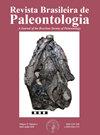Mesosaur taxonomy reappraisal: are Stereosternum and Brazilosaurus valid taxa?
IF 0.6
4区 地球科学
Q4 PALEONTOLOGY
引用次数: 2
Abstract
Mesosaurs are basal amniotes that lived at the beginning of the Permian or close to the Permo–Carboniferous boundary. Despite the several hundred specimens that have been found, including complete skeletons of adult and juvenile individuals, mesosaur taxonomy has been subjected to a high controversy over time. Currently, three monotypic genera, Mesosaurus tenuidens Gervais, Stereosternum tumidum Cope, and Brazilosaurus sanpauloensis Shikama & Ozaki are recognized, but identification of new specimens using the available diagnostic characters are arbitrary and influenced by high subjectivity. We performed anatomical and morphometric analyses to look for statistical support to these previously suggested basic diagnostic characters through an exhaustive anatomical revision of these characters and also of some new attributes discovered during the course of our study. We found a notable influence of taphonomic features in most of the diagnostic characters used to differentiate the three monotypic genera, including strong bias derived from the preservation of individuals in different ontogenetic stages, whose size and degree of ossification could have been controlled by particular environmental conditions that resulted in subtle polymorphisms of these and other few characters. Other features may even represent sexual dimorphism. After the detailed revision of the type specimens of the three currently accepted mesosaur taxa, for which we include here good-quality photographs, and considering the lack of statistical support for the most applied putative diagnostic features such as the different ratio found when comparing skull and cervical region lengths and the low or higher intensity of pachyosteosclerosis observed in dorsal ribs, which can be controlled by taphonomic and ecological conditions, we recognize Mesosaurus as the only mesosaurid taxon in the Paraná and Karoo basins, probably including dwarf individuals. Therefore, S.tumidum and B. sanpauloensis are suggested here as nomina dubia taking into account that the autapomorphies that supported these taxa cannot be confirmed to be absent in Mesosaurus. Keywords: Mesosaurus, morphometrics, taxonomy, ?Early Permian, Gondwana.中龙分类学的重新评估:立体胸骨龙和巴西龙是有效的分类群吗?
中龙是生活在二叠纪初期或接近二叠纪-石炭纪边界的基底羊膜动物。尽管已经发现了数百个标本,包括成年和幼年个体的完整骨骼,但随着时间的推移,中龙分类学一直受到高度争议。目前,三个单型属,细纹中龙属Gervais、立体胸龙属tumidum Cope和巴西龙属sanpauloensis Shikama&Ozaki已被认可,但使用现有诊断特征鉴定新标本是任意的,并受到高度主观性的影响。我们进行了解剖学和形态计量学分析,通过对这些特征以及在研究过程中发现的一些新特征进行详尽的解剖学修订,为这些先前提出的基本诊断特征寻找统计支持。我们发现,在用于区分这三个单型属的大多数诊断特征中,同源性特征都有显著影响,包括保存处于不同个体发育阶段的个体所产生的强烈偏见,其骨化的大小和程度可能受到特定环境条件的控制,这些环境条件导致了这些和其他少数性状的微妙多态性。其他特征甚至可能代表两性异形。在对目前接受的三个中龙分类群的模式标本进行详细修订后,我们在这里包括了高质量的照片,并考虑到缺乏对最适用的假定诊断特征的统计支持,例如在比较颅骨和颈部区域长度时发现的不同比率,以及在背肋观察到的低或高强度的粗肌硬化症,这可以由味觉和生态条件控制,我们认为中龙是Paraná和Karoo盆地中唯一的中龙分类单元,可能包括侏儒个体。因此,S.tumidum和B.sanpauloensis在这里被建议为名词dubia,考虑到支持这些分类群的自体形态不能被证实在中龙中不存在。关键词:中龙,形态计量学,分类学?早二叠世,冈瓦纳大陆。
本文章由计算机程序翻译,如有差异,请以英文原文为准。
求助全文
约1分钟内获得全文
求助全文
来源期刊

Revista Brasileira De Paleontologia
PALEONTOLOGY-
CiteScore
1.60
自引率
14.30%
发文量
25
审稿时长
>12 weeks
期刊介绍:
It publishes original contributions on all aspects of Paleontology. Papers are written in English, Spanish, or Portuguese and are reviewed by international experts.
 求助内容:
求助内容: 应助结果提醒方式:
应助结果提醒方式:


